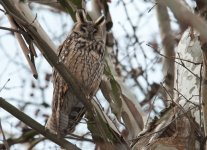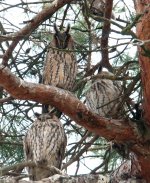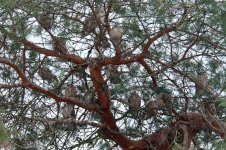-
Welcome to BirdForum, the internet's largest birding community with thousands of members from all over the world. The forums are dedicated to wild birds, birding, binoculars and equipment and all that goes with it.
Please register for an account to take part in the discussions in the forum, post your pictures in the gallery and more.
You are using an out of date browser. It may not display this or other websites correctly.
You should upgrade or use an alternative browser.
You should upgrade or use an alternative browser.
Where to see Long-eared Owls? (1 Viewer)
- Thread starter Benjaboo
- Start date
More options
Who Replied?John Cantelo
Well-known member
There's always been an amount of caution over publicising Long-eared Owl roosts (usually the only reliable way to see them) due to birds then being disturbed by birdwatchers but this is even more the case now with so many wanting to get closer to photograph them. Occasionally, as at Dungeness RSPB, birds roost where they can be seen but not disturbed (in the case of Dungeness thanks to a pool protecting the bird(s) from too close an approach). Hence it would be unwise, except in such a scenario, to publicise roosts here.
Andy Adcock
Worst person on Birdforum

Go to Kikinda in Serbia, hundreds in the Town square and it's a very easy, weekend trip.
Pygmy Cormorant can also be had easily in Belgrade in winter.
Pygmy Cormorant can also be had easily in Belgrade in winter.
Richard Prior
Halfway up an Alp

Go to Kikinda in Serbia, hundreds in the Town square and it's a very easy, weekend trip.
Pygmy Cormorant can also be had easily in Belgrade in winter.
Thats kinda outside Hertfordshire though Andy8-P
a_j_steele
Well-known member
Woods in the north east of herts are your best bet in the winter after twilight are your best bet as there have been historical in some winters
PYRTLE
Old Berkshire Boy

Appreciate your wishes and desires but as John has mentioned these known but declining day time roosts are quickly disturbed once the whereabouts are known. Perhaps join the county bird club and there may be a chance, however the species should be dispersed to a breeding territory now or very soon.
Good luck.
Good luck.
Andy Adcock
Worst person on Birdforum

Thats kinda outside Hertfordshire though Andy8-P
It's a really nice weekend trip, much better than the typical view you'll get of roosting birds in the UK.
A few of my wife's shots attached.
Attachments
Richard Prior
Halfway up an Alp

Crikey, wouldn't want to be a mouse in Serbia!
It's a really nice weekend trip, much better than the typical view you'll get of roosting birds in the UK.
A few of my wife's shots attached.
That is just absolutely wonderful, Andy! I hope you don't mind if I copy the last picture, just for my own collection. What's the max recorded at the site? The older I get, the more special every single Owl encounter seems: I don't care whether it's Barn, Long-eared, Tawny, Brown Wood or Barred Eagle Owl, they are just a completely different sensation to seeing any other kind of birds...
Andy Adcock
Worst person on Birdforum

That is just absolutely wonderful, Andy! I hope you don't mind if I copy the last picture, just for my own collection. What's the max recorded at the site? The older I get, the more special every single Owl encounter seems: I don't care whether it's Barn, Long-eared, Tawny, Brown Wood or Barred Eagle Owl, they are just a completely different sensation to seeing any other kind of birds...
No prob,
that shot was a double page, centrespread in Birdwatch magazine.
Max number on site is over 700.
https://www.serbia.com/kikinda-the-largest-winter-stationary-of-long-eared-owls-on-the-planet/
Last edited:
Thanks for the replies everyone so far!
I would never ask someone to just blurt out a roosting spot, I know how detrimental that would be!
I was just asking for some advice and broad locations I could try to spot them |=)|
AFAIK Deeping Lakes in S Lincs is OK to mention simply because the owls roost on the island of a lake and are therefore far less prone to disturbance. There have been up to 6 there recently. It's probably good to have a site such as this fairly public to stop them being harrassed elsewhere.
Autumn migrants can turn up almost anywhere and are less likely to be kept quiet. They're often on the east coast but we had a nice one just outside Cambridge a few years back. But like most other migrants it wasn't there for more than a day.
Hope this helps.
James
Benjaboo
Member
AFAIK Deeping Lakes in S Lincs is OK to mention simply because the owls roost on the island of a lake and are therefore far less prone to disturbance. There have been up to 6 there recently. It's probably good to have a site such as this fairly public to stop them being harrassed elsewhere.
Autumn migrants can turn up almost anywhere and are less likely to be kept quiet. They're often on the east coast but we had a nice one just outside Cambridge a few years back. But like most other migrants it wasn't there for more than a day.
Hope this helps.
James
Thanks very much, I will look into the that site!
I guess it's more of a matter of going out there and finding birds for yourself! I aim to try searching conifer shelterbelts and what not in mid summer to try and hear the young squeaky gate call of the young!
I know this has been previously asked but not for a long time...
I live in Hertfordshire in the UK and was wondering could anybody give tips or advice for seeing Long-eared Owls in Hertfordshire and around Cambridgeshire?
It's the one owl I'm yet to see!
A tip for you...Owls can be very responsive to high-pitched squeaking, if you can perfect the international distress call of a rabbit/rodent. I was told this while watching a roosting Northern Saw-whet Owl one December in the US. After watching the bird slip off its perch at dusk, I thought I'd try out the advice to see if I could attract any others (there were hundreds being caught nearby at the time). Within thirty seconds of me squeaking, I felt the wing of a LEO brush past my face and there it was, perched up, ears erect, staring back at me. I've done the same with SEOs after dark too; and I know others have attracted Barn Owls this way. Remember, it's squeaking, not pishing that works best.
Nutcracker
Stop Brexit!
Can be risky - there's a case of someone who did that, ending up with their lips pierced by a Tawny Owl's talons :eek!: :-OA tip for you...Owls can be very responsive to high-pitched squeaking, if you can perfect the international distress call of a rabbit/rodent. I was told this while watching a roosting Northern Saw-whet Owl one December in the US. After watching the bird slip off its perch at dusk, I thought I'd try out the advice to see if I could attract any others (there were hundreds being caught nearby at the time). Within thirty seconds of me squeaking, I felt the wing of a LEO brush past my face and there it was, perched up, ears erect, staring back at me. I've done the same with SEOs after dark too; and I know others have attracted Barn Owls this way. Remember, it's squeaking, not pishing that works best.
Can be risky - there's a case of someone who did that, ending up with their lips pierced by a Tawny Owl's talons :eek!: :-O
Seriously? Are you suggesting they were mistaken for a mouse? Or are you referring to the Eric Hoskings incident? I'm not advising squeaking in the breeding season; I'm talking about autumn/winter.
Nutcracker
Stop Brexit!
Yes - the location ability of their hearing is so acute, they can nail the exact position of prey by sound alone. And no, not Eric Hosking's incident, which was nest defence.
Yes - the location ability of their hearing is so acute, they can nail the exact position of prey by sound alone. And no, not Eric Hosking's incident, which was nest defence.
Sure, we know they locate by call alone, but where is the incident you refer to? I'm prepared to be amazed, but it still seems implausible that they would make that mistake? FWIW I do exercise caution where appropriate and suggest others do the same, but as I said, it's not something to be recommended with breeding birds; it's a technique I occasionally employ in the winter time and one I've had some notable success with. It involves 'kissing' the back of the hand, so the hand is there as self-defence, even if some discombobulated owl is unable to recognise a human presence as the source of the sound.
Benjaboo
Member
Sure, we know they locate by call alone, but where is the incident you refer to? I'm prepared to be amazed, but it still seems implausible that they would make that mistake? FWIW I do exercise caution where appropriate and suggest others do the same, but as I said, it's not something to be recommended with breeding birds; it's a technique I occasionally employ in the winter time and one I've had some notable success with. It involves 'kissing' the back of the hand, so the hand is there as self-defence, even if some discombobulated owl is unable to recognise a human presence as the source of the sound.
Hmm, sounds like an interesting idea, I might give that a go next time I'm out looking for owls thanks! |
Hmm, sounds like an interesting idea, I might give that a go next time I'm out looking for owls thanks! ||
With reference to Nutcracker's post above, please note Britseye & Friends Inc accept no personal liability for head wounds, ocular mutilations, limb removals or testicular disappearances incurred in pursuit of after dark Asios. Stay safe and good luck!
Similar threads
- Replies
- 0
- Views
- 523
Users who are viewing this thread
Total: 2 (members: 0, guests: 2)






